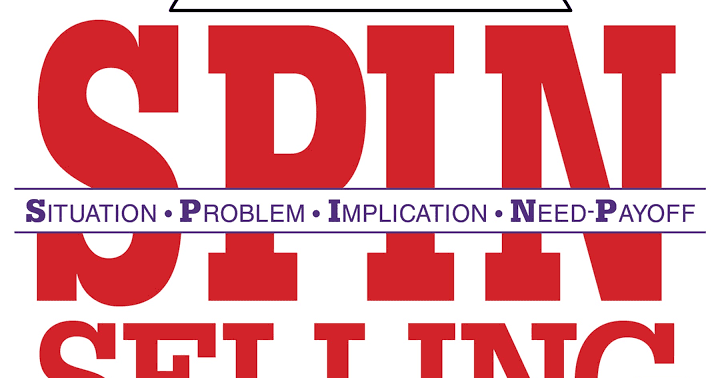If you work in B2B sales, you’ve probably heard of SPIN selling. It is one of the most well-known, if not the oldest, selling systems. SPIN selling provides sales representatives with a research-backed system for working and closing complicated transactions with lengthy sales processes.
SPIN principles should be used in conjunction with the existing sales approach. The SPIN selling strategy focuses on asking the right questions in the right order, active listening, and on translating the prospect’s expectations into the functionality of your product. Let’s see a summary of Neil Rackham’s book on SPIN selling.
What is SPIN Selling?
SPIN selling is a sales tactic derived from Neil Rackham’s 1988 classic novel, Spin Selling, which is based on 12 years of study and 35,000 sales calls. Neil Rackham argues in his book on SPIN selling that to create credibility as a trusted advisor, salespeople must abandon conventional sales tactics to win larger consultative deals.
Neil Rackham SPIN Selling Book Summary
We recommend reading the entire book to get the full effect of Neil Rackham’s guidance on SPIN selling. You can get it at the Amazon selling place
Here’s a quick summary of the contents SPIN selling strategy book:
Section 1: Introduction Sales Performance and Sales Behavior
- Closing is not as critical as most salespeople and managers believe.
- The importance of questioning is greater than most salespeople and managers realize.
- The ratio of closed-ended questions to open-ended questions does not predict sales performance.
- Great salespeople concentrate on avoiding, rather than dealing with, objections.
Section 2: Obtaining Commitment: Bringing the Sale to a Successful End
- Having the right commitment is critical to a successful closing.
- Representatives must plan ahead of time what their call goals will be.
- Every sales call has four possible outcomes: order, advance, continuation, and no-sales.
Section 3: Customer Needs in a Major Purchase
- Statements regarding challenges, concerns, and areas of frustration are examples of implicit needs.
- Unique features or functions are referred to as explicit needs.
- Explicit needs are good purchasing signals in broader sales.
Section 4: The SPIN Strategy
- Salespeople who close at a high rate often ask the same questions in the same order.
- There are four types of questions: Situation, Issue, Implication, and Need-Payoff.
- Each question form has a unique role to play in bringing the buyer closer to the sale.
Section 5: Giving Advantages in Major Sales
- The most popular way to pitch a product to a customer is through its features and benefits.
- Later in the sales phase, advantages are less successful. Users value features more than decision makers.
- Benefits have the most effect on buying decisions, but only when they are discussed at the end of the sales discussion.
Section6: Keeping Objections at Bay
- Objections are normally raised by the salesperson rather than the customer.
- The more benefits you present, the more objections you will face.
- To prevent unnecessary objections, develop needs before offering benefits.
Section 7: Launch of the Call
- Don’t use traditional opportunities, such as offering incentives or referring to the prospect’s personal interests.
- Get down to business as soon as possible and develop your target.
Section 8: Putting Theory into Action
- Adopt one SPIN Selling theory at a time to prevent being frustrated.
- Second, test them on smaller accounts or current customers.
Read Also: Consultative Selling Approach: Complete Guide to Consultative Sales
SPIN Selling Techniques
SPIN Selling is built around questions. Rackham and his colleagues discovered that top-performing salespeople rarely, if ever, ask random, low-value questions. Not only does each question serve a specific function, but the order in which they are asked is also strategic.
SPIN is an acronym that stands for the four phases of the questioning sequence:
- S: Situation
- P: Obstacle
- I: Implication
- N: Need Payoff
#1. Situation
Situational questions such as “What resources do you actually use?” serve as a means of gathering knowledge.
#2. Problem
Issue issues such as “Does this mechanism ever fail?” help to recognize the pains and challenges that prospects are experiencing.
#3. Implication
Implication issues such as “What is the efficiency cost when it does?” assist the sales rep in emphasizing that those pains must be addressed.
#4. Need Payoff
Need Payoff questions like “Wouldn’t it be easier if…?” enable the prospect to come to their own conclusions rather than jumping straight into a pitch.
Here are some additional examples:
Spin Selling Questions
- Do you have a plan in place to deal with X?
- Who is to blame for X?
- What happens if you don’t succeed with X?
- Is it possible for this mechanism to fail?
- What would you do with an extra [amount of money] every [week, month, quarter, year]?
- Has an issue with X ever had a negative effect on your KPIs?
- Can X make [positive event] easier to achieve?
- Would your team find… useful?
Now that we understand the purpose of each line of questioning, let’s look more closely at SPIN selling questions for each phase in the questioning series.
SPIN Selling Situation Questions
Use Situation questions to learn about the prospects’ processes and pain points, as well as their competitive strategies and outcomes. The specific questions will vary depending on the product; for example, if you provide leadership training for mid-level managers, you may inquire, “How do you currently teach first-time managers best practices and strategies?” ”
If you sell office supplies, you may wonder, “How do you buy office supplies right now?” ”
Here are some sample questions that you can adapt for your own use:
- What are your responsibilities at [company]?
- How do you go about doing X?
- What is your approach to X?
- Tell me about your day.
- Do you have a plan in place to deal with X?
- Who is to blame for X?
- How long have you been doing X in this manner?
- Why do you do X in this manner?
- How much money do you have set aside for X?
- Why do you do X in this manner?
- How relevant is X to your company?
- Who is the most likely to use X? What are their goals?
- What methods do you actually use to accomplish X?
- Who is your new X vendor?
- Why did you pick your new X vendor?
Take note of the lack of fact-gathering questions such as “How big is your company?” ”, “How many branches do you have?” ”, “What kinds of things do you sell?” ”, and so forth.
There wasn’t nearly as much detail available to sellers when Neil Rackham released “SPIN Selling.” Many situational questions are no longer effective now that you can find a long list of key information about your prospect with a fast online search.
These questions not only make customers impatient, but they also leave less time for the most important ones. Ask a few questions in this category as possible – and make sure you’ve done your homework before the call.
SPIN Selling Problem Questions
Reps identify potential areas of opportunity at this point. In other words, what void remains unfilled? Where does the prospect express dissatisfaction? They may be unaware that they have a problem, so investigate the popular areas where your solution adds value.
- How long does X take to complete?
- How much does X cost?
- So, how many people are needed to produce the desired results?
- What happens if you don’t succeed with X?
- Is it possible for this mechanism to fail?
- Are you happy with your current X process? What were the outcomes?
- What is the dependability of your equipment?
- Is it usually simple to find out what went wrong when you have a problem?
- How much work is needed to repair or replace your tools?
- Are you satisfied with your new vendor?
SPIN Selling Implication Questions
Determine the gravity of the problem until you’ve established it. Implication questions show the extent and magnitude of your prospect’s pain point, providing you with useful knowledge for customizing your message and instilling urgency in the consumer.
According to Neil Rackham in SPIN selling, by the end of this section of the discussion, they should have a new understanding of the issue.
According to Rackham, top-performing salespeople pose four times as many Implication questions as their typical counterparts.
- What is the efficiency cost of doing X in this manner?
- What would you be able to do if you had an extra [amount of time] per [week, month]?
- Will your customers be more happy, committed, and loyal if you didn’t have an X-related problem?
- Will it be easier to accomplish [primary goal] if you didn’t have to deal with [issue]?
- Is it ever the case that [issue] prevents you from meeting your objectives in [business area]?
- When was the last time X failed to function?
- How is [problem] affecting your team members?
- Will you consider [issue] to be a hindrance to your personal career development?
- Will saving [amount of time] have a major impact on your [team, budget, or company]?
- What would you do with an extra [amount of money] every [week, month, quarter, year]?
- Has an issue with X ever had a negative effect on your KPIs?
SPIN Selling Need Payoff Questions
Need Payoff questions to allow prospects to clarify the advantages of your product on their own terms, which is much more convincing than listening to you describe certain benefits.
Essentially, you are asking questions that bring to light the potential of your offering to assist them with their core needs or issues. These questions center on the solution’s worth, significance, or usefulness.
Be certain that your Need Payoff questions do not illustrate problems that your product cannot solve. For example, if you assist corporate recruitment teams in identifying qualified engineering applicants, you do not inquire about the effect of hiring better marketers.
Fortunately, developing Need Payoff questions is reasonably simple; they should follow directly from your Implication questions.
“Has an issue with X ever stopped you from meeting a deadline?” is an example of an Implication query. ”
Question for Need Payoff: “Would it be easier to reach your deadlines if you could do X in half the time?” ”
Customizable Need Payoff questions include the following:
- Will it be helpful if…?
- Can X make [positive event] easier to achieve?
- Would your team find… useful?
- Do you believe that resolving [problem] will have a big effect on you in Y way?
- Is it critical for your team members to see X benefit in order for them to take Y action?
Caution: Need Payoff questions will backfire. You can come across as condescending if they are too obvious. Try to reframe the solution in a way that the buyer hasn’t considered before.
For example, rather than asking, “Would your business benefit from cost savings?” “Would redirecting $1,000 per week from your content development budget and putting it into Facebook ads drive substantial traffic to your blog?” you might ask. ”
SPIN Sale’s Four Stages
Remember the lifecycle of your conversation when you continue to use SPIN selling questions with prospects. According to Neil Rackham in SPIN selling, every sale goes through four basic stages:
#1. Opening
SPIN Selling and inbound sales both approach the first or connect, call in the same way. Reps should not dive right into their product’s features and benefits; not only will this excessively offensive approach turn off customers, but salespeople will also miss out on useful details.
The connect call’s goal is to capture the buyer’s attention and begin to win their confidence. Begin with an enticing perspective or a thought-provoking query.
#2. Investigating
The investigation process of SPIN Selling is the most critical. It’s similar to a discovery call in that you’re determining how your product will benefit the customer, defining their preferences and purchasing requirements, and gaining credibility by asking appropriate, focused, strategic questions.
A good query strategy, according to Neil Rackham in SPIN selling, will increase your close rate by 20%.
#3. Demonstrating Capability
After you’ve connected the dots between your approach and the prospect’s needs, you must demonstrate the relation.
According to Rackham, there are three simple ways to explain the product’s capabilities:
- Features
When selling low-cost, basic goods, features are especially useful. A cup feature could be, “It can accommodate 10 ounces of liquid.” End-users find features more appealing than decision-makers, who are concerned with the bottom line.
- The Benefits
Advantages explain how a product’s functionality is used in practice. They, like benefits, are useful for smaller transactions but less so for larger ones. The benefit of a cup maybe that “you can use it to drink both hot and cold drinks.”
- Advantages
Benefits take things a step further by demonstrating how a function will benefit the prospect. They usually have a financial aspect and meet the needs of your customer (s). A well-crafted benefit persuades the consumer to purchase your product. Your cup’s advantage maybe, “Since you drink coffee in the morning and iced coffee in the afternoon, you’ll appreciate this mug’s versatility.” You can now enjoy both drinks in a single cup.”
The FAB formula provides another way to consider characteristics, advantages, and benefits.
Since [product] includes [feature]…
[User] would be able to [benefit]…This means that [prospect] would benefit from [benefit].
Fill in the blanks for a salesperson selling employee gamification apps.
“Because our platform allows you to build leaderboards for your service teams, customer support representatives can have a real-time view of their success in comparison to their peers. As a result, they will be inspired to improve their overall satisfaction rating and react to tickets more quickly.”
#4. Objections
Objections are unavoidable in any transaction. In reality, if you’re not getting them, you should be concerned because it means your prospect has reservations that they’re not sharing with you. Your aim is to figure out why the customer hasn’t already made the purchase, and then to make them understand why their issues aren’t true roadblocks.
(Of course, if there is a legitimate reason your product isn’t a good match, you shouldn’t try to convince them otherwise.)
According to Neil Rackham in his book on SPIN selling, there are two forms of objections:
#1. Value:
Your prospect isn’t sure of the ROI of your offering. They might say, “I like its features, but the price is prohibitively expensive.”
#2. Capability:
Your prospect is skeptical that your product will fulfill their unique requirements. That translates to statements like, “I’m not sure it’ll be able to do X for us,” “That process seems to take longer than you suggest,” and “I think we need a more robust solution.”
Capability objections may be further subdivided as follows:
- Can’t: The solution is unable to address one of the buyer’s top priorities.
- Can: The solution has the potential to address one of their top goals, but they are unaware of it.
It is important to avoid as many objections as possible. The majority of objections are avoidable if you don’t sell too fast.
Neil Rackham’s research in his book on SPIN selling showed that by using inference and need-payoff questions to create value before proposing a response, reps can cut the number of objections in half.
The salesperson poses a Problem question in the standard series. The prospect’s response is then used to give the corresponding product function.
However, the rep frequently lacks sufficient background to better grasp what the prospect is attempting to achieve or what is impeding her progress. Their generic, one-size-fits-all response prompts the buyer to object, and she is unlikely to listen to any future suggestions.
Instead, try the SPIN sequence. Ask a Problem question, then probe into the implications with Implication questions, and finally, with a Need Payoff question, ask the buyer to consider the importance of a solution.
Measuring Progress with SPIN Selling Outcomes
Transactional salespeople also go through all four stages in a single sales call. Reps working on larger, more complicated transactions, on the other hand, can take two months to two years to complete. In situations like these, the SPIN selling approach provides four potential outcomes for each sales call:
#1. Advance
Rackham employs the idea of “advances” to assist mid-market and business salespeople in measuring their success. An advance is an activity the consumer agrees to that takes you closer to a purchase.
The keyword here is intervention. It’s tempting to read your prospect’s request for more details or a plan as a buying signal, but doing so puts the ball squarely in your court. If the buyer is really interested, they may also agree to do some work.
#2. Continuation
A sales dialog that ends with an unfavorable result is referred to as a continuation. In other terms, when you end the call or conference, the buyer has not agreed to any next steps that will move the transaction forward.
A prospect checking your pricing page and sending you questions, signing up for a free trial and testing the tool, or introducing you to a key stakeholder are all examples of advances.
Produce as many useful breakthroughs as possible. The more routes to the sale you have, the more likely it is that you can get there. When a prospect declines one of your advances, such as an introduction to Procurement, you should consider the rejection calmly and then suggest something else.
#3. Order
The third possible outcome of a sales call is an order. The customer decides to buy your product and expresses their firm willingness to do so by signing paperwork. For large transactions, this is normally the final result is a sequence of increasingly larger closes.
#4. No-Sale
The fourth (and least desirable) result is a no-sale. Your prospect declines your request: you can’t meet with the decision-maker, they won’t arrange another meeting, or, at worse, they say there’s no way you’ll work together.
Modern-Day SPIN Selling Suggestions
“SPIN Selling” was first written over 30 years ago. The traditional buying journey has transformed, despite the fact that its core strategies and values remain unchanged. If you’re going to use the SPIN model, you can make sure it’s up to date.
#1. As little as possible, ask Situation and Problem questions.
Prospects obviously do not have the time to do your research for you. They don’t want you to describe pain points they already know about; if they did, they’d just buy the cure themselves. You are important because you can identify opportunities or pain points that your customers are unaware of.
With this in mind, ask provocative questions like, “Has your company ever considered [new strategy]?”, “Do you know [surprising statistic]?”, and “Would you like any tips for planning for [impending industry event]?”
Rackham did not categorize these issues, but they are unquestionably useful in modern sales.
LinkedIn did not exist when Rackham published “SPIN Selling.” You now have much more knowledge of the customers’ viewpoints, priorities, and attitudes than salespeople in the late 1980s might have imagined. Don’t squander this precious resource.
Read through your prospect’s profile(s), look through their community comments and any posts they’ve written or posted, look through their Recommendations section to get a sense of their work ethic, and so on. Before your kick-off sales call, get to know each customer as well as possible so you can involve them as if it’s the fifth meeting, not the first.
#3. Guide their purchasing process.
Your experience becomes more important as the average number of stakeholders involved in any B2B transaction increases, and internal purchasing processes become more complex. Prospects rely on you to assist them in purchasing your goods in ways they have never done before. Bring the job titles – and possibly the names, if you can locate them – of their colleagues who need to be informed or consulted.
Inform your point of contact about what their boss may like to know before approving the decision, and give them materials to make their presentation more convincing. Collaborate with your contact to foresee and prevent potential stumbling blocks. Liaise with Procurement and/or Legal as required to get the deal completed as rapidly and efficiently as possible. While Neil Rackham did not include these suggestions in “SPIN Selling,” they are one of the most successful ways to distinguish yourself in modern sales.
What is the future of SPIN selling in sales?
In the future, SPIN selling is expected to continue to be a popular and effective method of selling. With the growth of technology and changes in customer behavior, it may need to be adapted to meet new challenges, but the core principles of SPIN selling will remain relevant.
How has SPIN selling evolved over the years?
SPIN selling has evolved significantly since it was first introduced. As sales environments have changed, the method has been updated to keep pace. For example, with the growth of remote sales, SPIN selling has been adapted to ensure that it can be used effectively in virtual environments.
Can SPIN selling be used in sales negotiations?
Yes, SPIN selling can be used in sales negotiations. By using the SPIN process to understand the customer’s needs and objections, you can be better prepared to negotiate effectively.
Can SPIN selling be adapted for remote sales?
Yes, SPIN selling can be adapted for remote sales. While some elements may need to be modified to account for the lack of in-person interaction, the core principles of SPIN selling remain relevant in a remote sales environment.
How do you measure the success of SPIN selling?
The success of SPIN selling can be measured in a number of ways, including increased sales, improved customer satisfaction, and increased customer loyalty. Measuring the success of SPIN selling requires a combination of quantitative and qualitative data.
How do you continuously improve your SPIN selling skills?
Continuously improving your SPIN selling skills requires a commitment to ongoing learning and development. This can include attending training sessions, participating in coaching and mentoring programs, and seeking feedback from customers and colleagues.
Spin Selling FAQs
Does Spin selling still work?
After being published in 1988, “SPIN Selling” is still relevant and is considered the ultimate how-to guide on problem-solving. It does so by creating value through an ongoing relationship with the buyer. In the sales world today, you can abandon most traditional sales techniques.
What are the four stages of SPIN Selling?
Prepare a presentation that includes the four stages of SPIN selling (opening, investigation, demonstrating capability, and gaining commitment). Include the four types of questions during the investigation stage (situation, problem, implication, and need-payoff).
What is SPIN selling with examples?
SPIN selling is a sales technique designed to help sales reps close difficult, complicated deals. The acronym SPIN represents the categories for different types of questions: situation, problem, implication, and need-payoff. Situation questions help reps learn more about each prospect’s current state
What is Spin analysis?
SPIN = Situation, Problem, Implication, Need / Payoff. Don’t treat the questions above as a checklist. To identify the ones that make the most sense to your business and your prospect, and work them naturally into your conversation






